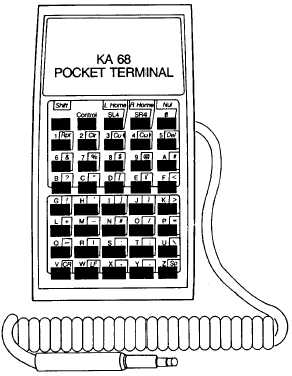TM 1-1510-218-10
3B-61
Figure 3B-22. Pocket Terminal
Enter the title by pressing the appropriate keys
on the pocket terminal. The title may consist of any
combination of alphanumeric characters, spaces or
punctuation up to a length of 27 characters (1 line).
Any of the shaded functions are obtained by pressing
the SHIFT key prior to pressing the key with the
desired function. For example, to obtain a space,
press and release the SHIFT key and then press the
key placarded SP. As the title is entered, a white CSR
BLK appears to the right of the last entered character
indicating the location where the next character will be
inserted. When the title is complete, it must be
terminated by a carriage return, SHIFT – CR, to make
the cursor disappear.
(2) Programming Checklist Items. Enter the
checklist item by pressing the appropriate keys on the
pocket terminal. A checklist item may consist of any
combination of alphanumeric characters, spaces, or
punctuation up to a length of 15 lines (450 characters).
If the item is longer than one line long, do not use the
carriage return to move from one line to the next. Use
spaces as necessary to move the cursor to the end of
the line and to the beginning of the following line. The
carriage return should be used only at the end of the
entire item to make the cursor disappear.
(3) Error Correction. Error correction is
accomplished with the delete function, SHIFT – DEL,
on the pocket terminal. While in insert mode (cursor
on the screen), pressing SHIFT – DEL will delete
individual characters. Once an item has been
terminated with a carriage return (no cursor on the
screen), SHIFT – DELETE will delete the entire
selected item (shown in yellow).
c. Special
Functions.
Certain
special
functions can be obtained on the pocket terminal by
pressing the CONTROL key prior to pressing X, C, or
I. CONTROL – X erases everything (all checklists)
stored in nonvolatile memory in the KGR-358. After
pressing CONTROL – X, the message ERASE
ENTIRE MEMORY YES/NO appears on the radar
screen. If Y-E-S is entered, the radar graphics unit will
carry out the command. If N-O or any other key is
pressed, the erase command is aborted. CONTROL –
C on the pocket terminal duplicates the function of the
PAGE button on the radar graphics control panel.
CONTROL – I on the pocket terminal duplicates the
function of the IDX button on the radar graphics control
panel.
3B-31. GROUND
PROXIMITY
ALTITUDE
ADVISORY SYSTEM.
The ground proximity altitude advisory
system will provide little, if any, warning
for
flight
into
precipitous
terrain
approaching a sheer wall if there is little
gradually rising terrain before reaching the
steep terrain.
a. Description. The Ground Proximity Altitude
Advisory System (GPAAS) is provided to aid the flight
crew in terrain avoidance. Refer to Figure 3B-23.
The GPAAS is a completely automatic system
(requiring no input from the crew) which continuously
monitors the aircraft's flight path at altitudes of
between 100 and 2000 feet Above Ground Level
(AGL).
The GPAAS computer processes the data and,
when conditions warrant, selects the appropriate
digitized voice advisory/warning message from its
memory. This message is then announced over the
pilot's and copilot's audio systems. If the condition is
not corrected, the GPAAS will rearm, and will again
announce and repeat the warning if the condition
recurs. The GPAAS computer remains ready to
announce a different message during the intervals
between repetitions. All messages are disabled below
100 feet AGL.
WARNING


